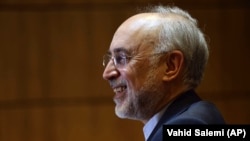Head of the Atomic Energy Organization of Iran (AEOI), Ali Akbar Salehi, announced on Sunday, January 13, that the country has taken the "first steps" toward developing a 20%-enriched fuel used for Tehran nuclear reactor.
In an interview with the monopolized state-run Radio&TV news agency (IRIB), Salehi claimed, "The new version of the fuel is different from the older one, and it would boost the reactor's efficiency."
Salehi went further by claiming that the country is on the verge of designing the new, upgraded fuel that can be used in any reactor.
“Designing reactors has now become a very possible task for Iranian experts,” he insisted.
The nuclear chief then noted the Iranian nuclear scientists’ success at producing the raw material for the tracer FDG (fluorodeoxyglucose), which is used in PET scan, adding “the raw material for FDG is Oxygen-18, which we succeeded in producing in Arak reactor with 95% purity,” state-run Mehr News Agency (MNA) cited him as saying.
He also asserted that once the hydrolysis stage is completed, Iran will no longer need to export Oxygen-18.
Washington and its close allies have always been worried that the Islamic Republic might use highly enriched uranium for producing nuclear weapons, under the cover of a peaceful atomic program. Tehran, for its part, has repeatedly insisted that such allegations are unfounded, and its nuclear program is "absolutely peaceful".
Prior to the Joint Comprehensive Plan of Action (JCPOA) or Tehran's nuclear deal with world powers in 2015, Iran used to enrich uranium up to 3.5%, and in a certain period to 20% and higher, but, based on the deal, the country is committed to limiting its uranium enrichment at 3.67% for fifteen years.
Based on the same deal, Iran is going to procure the 20% enriched uranium needed for the Tehran reactor from Russia.
The Tehran Research Reactor (TRR) was supplied by the United States under President Dwight D. Eisenhower's Atoms for Peace program in 1953.
Two years later, the king of Iran, Mohammad Reza Shah Pahlavi established the Tehran Nuclear Research Center (TNRC), located at the University of Tehran, and began to negotiate with the United States to provide Iran with nuclear technology and materials.
The five-megawatt pool-type nuclear research reactor, granted by the US, became operational in 1967 and used for medical and agricultural purposes.
“In the nuclear science and industry, we have made so much progress that we can design modern fuel ourselves instead of reverse engineering and using others’ designs, which is a great achievement for the country,” Salehi told the Islamic Republic of Iran Broadcasting (IRIB).
Meanwhile, the spokesman of AEOI has cautioned that if talks between Tehran an EU for keeping JCPOA alive hit a dead-end, the Islamic Republic would resume enriching uranium up to 20%.





